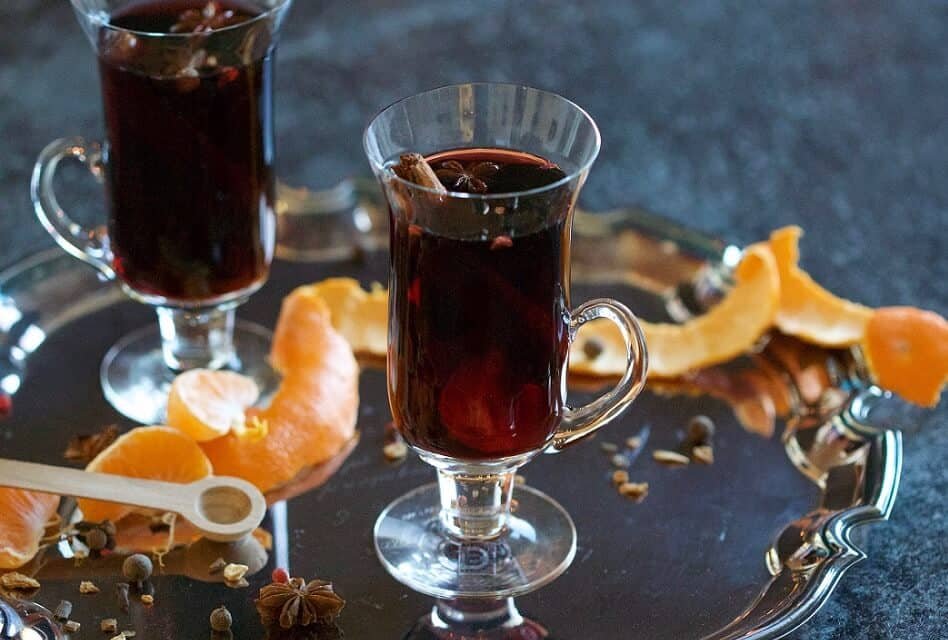Many people enjoy their wine sitting by the chimney in the cold winter months. Or, they simply heat it. Mulled wine is the most popular drink at Christmas markets around the world. But you can also enjoy your homemade version at home.
Mulled wine is a wine cocktail made from red or white wine and multiple spices. Traditionally, it is served as a hot beverage in winter, particularly at Christmas markets. Many producers offer ready-to-drink bottles, but it can also be made easily at home.
While you can buy ready-to-drink mulled wine in bottles, you can also make it at home. And, of course, you can find it being sold at Christmas markets. In this article, we will discuss the history, the ingredients, and how to enjoy mulled wine.
WHAT DOES MULLED WINE MEAN?
Mulled wine means heated and spiced wine. The process of mulling is not exclusive to wine, though. You can also heat other beverages, such as cider or gin, and enrich them with sugar and spices to create hot, flavored drinks. To some degree, you can compare the process to brewing tea.
WHERE DOES MULLED WINE COME FROM?
The Romans were the first to drink hot wine in the 2nd century. Wine was a famous beverage in the Roman empire. Besides its intoxicating capabilities, people considered it a safe drink compared to water that was often polluted. And in the cold winters, especially Roman soldiers heated their wine to warm themselves up and avoid getting sick. While the Roman armies conquered most of Europe, their heated wines became famous across their whole empire. And over the centuries, more and more variations came up. People added various medicinal herbs to increase the wine’s positive impact on health, and they improved its taste with sweetening plants.
By the end of the medievals, the star of mulled wine was sunken in most of Europe. Only the Swedes maintained their enthusiasm for their hot wine version: Glögg. The drink was mentioned in 1609 for the first time and became even more popular when cognac-infused variations came up in the 19th century. The European renaissance of mulled wine started when more and more people associated the Swedish Glögg with Christmas in the 1890s. Wine merchants quickly picked up this trend and created their own recipes and unique bottles that typically showed Santa Claus.
In the following decades, mulled wine became popular all across the globe, leading to new variations made from white wine, Port wine, or Vermouth.
Are Mulled Wine and Glühwein the Same?
Glühwein is simply the German translation of the term. Literally, it means “smoldering wine”. On every German Weihnachtsmarkt (English: Christmas market), there is at least one Glühwein booth, and you can find many different variations with various spices and spirits added throughout the country.
Other Names for Hot Wines
Besides the German term Glühwein, you can find many synonyms for the same beverage:
- In Scandinavia, it is called Glögg or Gløgg. Many recipes include spirits such as brandy or aquavit.
- In France, you can find Vin Chaud, which is typically made with honey.
- The Portuguese serve Vinho Quente, which contains Port or Madeira wine.
- The Polish call it Grzane Piwo. Often, they make it with beer instead of wine, though.
- In the Czech Republic, people enjoy Svařené Víno while their neighbors in Slovakia drink Varené Vino.
- The Hungarians call their version Forralt Bor.
- Honey and black pepper are crucial ingredients for Romanian Izvar.
WHAT IS MULLED WINE MADE FROM?
The main ingredient is wine, of course. While you can make other red wine cocktails with all types of red wine, mulled wine calls for a full-bodied, dry, fruity red wine, such as Cabernet Sauvignon, Merlot, Syrah, or Zinfandel.
For making white mulled wine, aromatic wines like Riesling or Moscato are great choices.
In addition, various other ingredients are needed:
- Oranges add citrus flavors and a bit of acidity.
- Sugar (white or brown), honey, or maple syrup sweeten the drink.
- Spices such as cinnamon, clove, anise, nutmeg, cardamom, or vanilla give the mulled wine its typical Christmas-like flavor.
- Optional spirits like brandy, vodka, or Grand Marnier can provide an extra kick and additional aromas.
HOW TO MAKE MULLED WINE AT HOME
Making mulled wine is not hard. The most straightforward way to make it consists of only three basic steps:
- First, grind the spices into tiny pieces.
- Next, put them into a bag made from cheesecloth or into a single-use tea filter bag.
- Heat the wine together with orange slices, the filled spice bag, and sugar for about 15 to 20 minutes.
Of course, there are many options to vary this process. For instance, you can waive grinding the spices and instead use bigger pieces. Especially cinnamon sticks and star anise look great as garnishments, too. Another common technique is to stick the spices into the orange slices instead of putting them into bags.

Can Mulled Wine Be Made in Advance?
If you prepare it at home, you can make it one to two days in advance and reheat it when you want to serve it. Be aware that its total lifespan is relatively short. You should not keep it for more than three days after preparing it.
WHAT DOES MULLED WINE TASTE LIKE?
Mulled wines inherit most aromas from the table wines used as the main ingredient. So if you use a bold, fruity red, the mulled wine will have similar characteristics. However, the other ingredients add aromas to the experience:
- The sugar (or the alternative sweeteners) makes it significantly sweeter than table wine.
- Oranges contribute perceivable citrus flavors and some acidity.
- The spices add typical Christmas flavors.
- The fact that it comes hot also makes a difference because heat emphasizes acidity and astringency.
So, in summary, mulled wine is sweeter, fruitier, and a bit sourer than regular table wine.
Is Mulled Wine Stronger Than Wine?
In general, it has slightly less alcohol than regular wine. The reason is temperature: When you heat the wine, the alcohol will slowly evaporate. The hotter it is, and the longer you heat it, the more alcohol will be gone.
However, some recipes call for spirits like brandy to add to the mix. If that is the case, your hot wine can be stronger than table wine.
Of course, you can waive the alcohol completely. Simply choose a non-alcohol wine for your recipe, and you can make a mulled wine that won’t make you tipsy.
HOW TO STORE MULLED WINE
If you buy a ready-to-drink bottle, store it like any other table wine:
- Keep it in a cool room where it is not exposed to sudden temperature changes.
- Shield it from sunlight.
- Do not store it close to aggressively smelling chemicals such as heating oil, wall paint, or cleaning agents. Otherwise, the odors might invade the bottle and ruin the wine.
- Protect it from vibrating devices like air conditioning or washing machines.
Can Mulled Wine Go Off?
Mulled wine can go off if you leave it in contact with air for too long. Eventually, it will get sour and develop vinegar-like odors.
How Long Does Mulled Wine Last When Open?
An open bottle lasts for about 3 days, and the same is valid for homemade preparations. Make sure to follow these rules to maximize its lifespan:
- Let the wine cool down to room temperature before storing it.
- Put it back into the bottle. Use a glass bottle or a jar with a lid for homemade mulled wine.
- Reseal the bottle with the original cork or a reusable bottle stopper.
- Store it in your regular fridge.
Can Mulled Wine Be Reheated?
You can reheat leftovers even after they get cold. Make sure to do it gently over low heat, though. Otherwise, the alcohol will evaporate too rapidly.
Can Mulled Wine Be Frozen?
It is possible to freeze mulled wine and consume it for up to 6 months afterward. You cannot use the original bottle or another glass vessel for this purpose, though. Instead, use a plastic container (for instance, Tupperware), a freezer-safe plastic bag with a zipper, or ice cube trays. In any case, let the wine cool down to room temperature before portioning it and putting it into the freezer.
Can Mulled Wine Be Aged?
Mulled wine has no aging potential whatsoever. Thus, it does not make sense to keep it in your basement for an extended period. You better drink it soon after buying it.
HOW TO SERVE MULLED WINE
The most common way to enjoy mulled wine is at a Christmas market booth, surrounding a patio heater, and watching the snowfall. But of course, you can also have it in your living room with some cookies.
What Is the Best Serving Temperature?
When serving mulled wine, aim for a serving temperature between 140 and 160°F (60-70°C).
What Is the Best Glass for Mulled Wine?
Of course, you cannot serve hot wine in a regular wine glass. Besides the risk of shattering the glass, your guests would probably burn their hands. The right pick is a coffee mug.
Should You Decant Mulled Wine?
Decanting mulled wine does not do anything. If you leave it in a decanter, it will only cool off. So waive the decanting and serve it to your guests right after heating it so they can enjoy it at the optimal temperature.
MULLED WINE FOOD PAIRING
A hot beverage is a rather weird pairing for dinner. And with its intense combination of sweet and spicy notes, mulled wine isn’t a good match for the main course. Nevertheless, you can combine it with food.
Go for finger foods, for example, cold cuts and cheese plates. In particular creamy types such as Camembert are great choices. Blue cheese is another option, so try a Roquefort or a Stilton. The latter is very good with Port-based preparations.
Nuts are another food to pair with mulled wine, especially when roasted in honey or coated with barbecue spices or herbs.
In Sweden and other Scandinavian countries, people like their hot wine with fermented fish or vegetables.
And finally, it makes perfect sense to pair it with spiced Christmas pastries. Especially gingerbread cookies or speculoos are perfect matches.
FINAL WORDS
Mulled wine is fantastic for keeping yourself warm on a cold winter day. No matter if you enjoy it at a Christmas market or home, it is the perfect drink for the snowy season.
Recent Posts
Switzerland is famous not only for its beautiful landscapes and its picturesque towns but also for some food items. Especially Swiss cheese and chocolate are world-famous. But do you actually know a...
Winemaking is a sophisticated process that includes multiple steps and can take several years. Depending on the desired wine and the vintner's preferred techniques, these steps can differ. However,...

